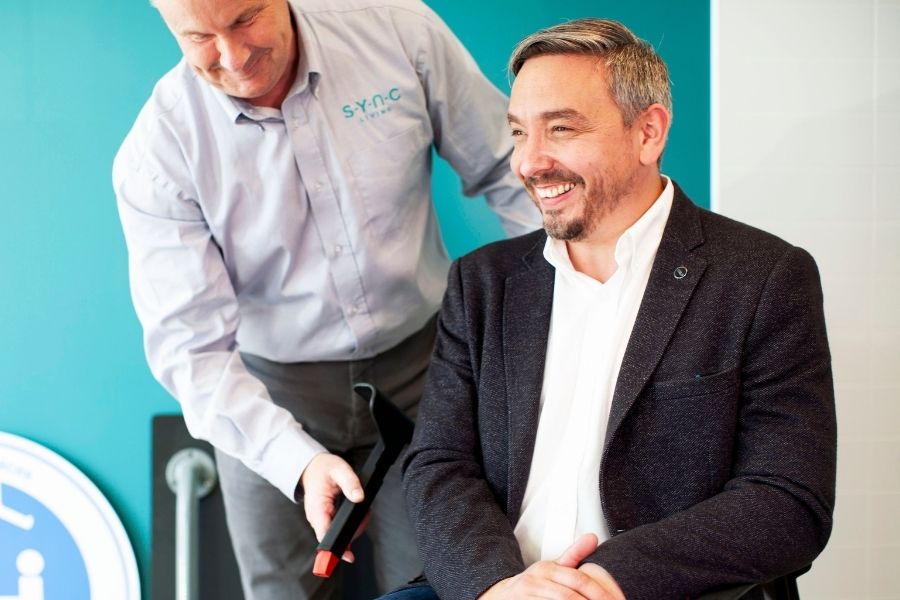Powered Wheelchair Assessments Northern Ireland
Sync Living has a team of wheelchair and seating specialists who work with healthcare professionals such as OTs, to provide assessments and technical support. One particular service is assessments for powered wheelchairs. Sync Living are based on York Road in Belfast, and help users and health trusts right across Northern Ireland. So what is involved in a powered wheelchair assessment, and why is this service needed?
Powered Wheelchair Healthcare Consultations and Advice
If you think you could benefit from a wheelchair all or most of the time, then ask a GP, physiotherapist or occupational therapist to refer you to your local wheelchair service for an assessment. They’ll advise if you need a wheelchair and if so, what type. It is always a good idea to consult a healthcare professional to assist in the decision making process. Sync Living can assist healthcare professionals in powered wheelchair assessments, and we have a proud relationship with healthcare trusts right across Northern Ireland.
There are a number of factors to consider during an assessment; including your body type, skin condition, posture and strength. We will discuss what type of powered wheelchair the user will need; whether it is indoor only powerchair, an outdoor only powerchair, or one that is suited to both indoor and outdoor use. Will the chair need to be transported – for instance folded and put in a car boot. If you have a health condition that is likely to progress with time, it’s a good idea to take account of your possible future needs when choosing a wheelchair, too. So what should you expect during an electric wheelchair assessment?
What happens at a powered wheelchair assessment?
A powered wheelchair assessment involves finding the wheelchair that is best for you; based on your needs, body type, and health conditions. Assessments typically involve the following stages;
1. Initial Consultation
Together we will discuss the user’s needs and essential details, including; height, weight, age, what conditions they have, what problems they are facing, and so on. This conversation may also involve the user’s family, case manager, carers, OTs, other healthcare professionals, and the client themselves.
2. Setting Goals & Specifications
After this consultation, a face-to-face meeting will be booked to go over goals and determine what the client wants to achieve in the future. These may include increased independence, the control they require over their mobility, and improved posture.
3. Taking Size Measurements
Taking a range of user size measurements will allow us to generate a detailed specification draft for the powerchair. These body measurements will include; Leg length depth and height, hip width, height to shoulder and head, and more.
4. Trying a Demo Model
From this prescription we will build a demonstration model of the recommended powerchair, which the user can try out. Adjustments can be made to make sure the wheelchair meets their specific user requirements.
5. Delivery
When the powerchair is fully built to specification, it’s time to arrange delivery. The delivery may involve the user’s key support group. This might include family, occupational therapist, and anyone involved in finding the right wheelchair. There will be a handover including final adjustments, set up, and training on operating and maintaining the powerchair.
6. Review
Once the user is able to try their new powered wheelchair in different scenarios and settings! If there are any issues or concerns, simply get in touch and we can arrange further visits to refine any detailed requirements. The main aim is making sure the powerchair meets the user’s needs, and continues to enhance their quality of life.
Powered Wheelchair Seating and Postural Positioning
Seating positioning is a crucial part of selecting a wheelchair, both for comfort and support. The key to stability is a neutral pelvic position, which must be considered during the fitting of the seat positioning. In a seated position, the natural curves of the back and neck should be supported; and the shoulders, pelvis and knees should ideally be level. This does however depend on the individual case and needs of the user, such as whether they have the ability to control their body position. The seat position must also sit over the wheelchair’s centre of gravity – just in front of the wheelchair’s rear wheels.
Electric Wheelchair Assessments Belfast and Northern Ireland
Sync Living are based on York Road in Belfast, and help customers and health trusts right across Northern Ireland. As well as providing powered wheelchair assessments, we supply a range of powered wheelchairs including folding powered wheelchairs, prescription powered wheelchairs, standing powered wheelchairs, and bariatric powered wheelchairs.
If you want to discuss the requirements for an electric wheelchair assessment, or a manual wheelchair, then you can call us on 028 9074 5333, or send us an email sales@syncliving.co.uk – We’ll be more than happy to help!
